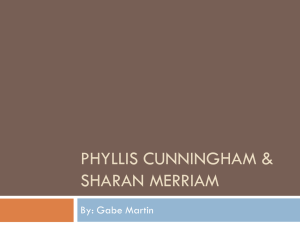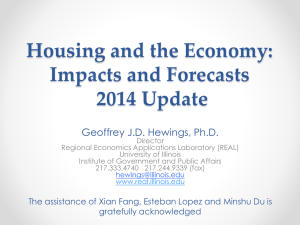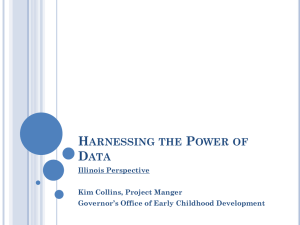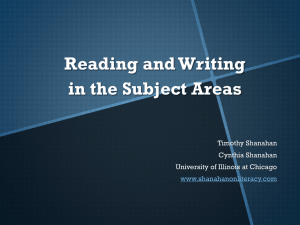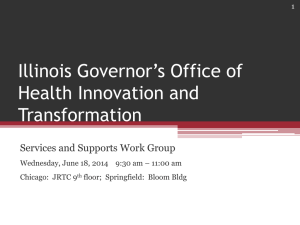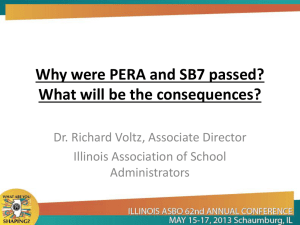regulatory innovation - Insurance Industry Legislative Day
advertisement
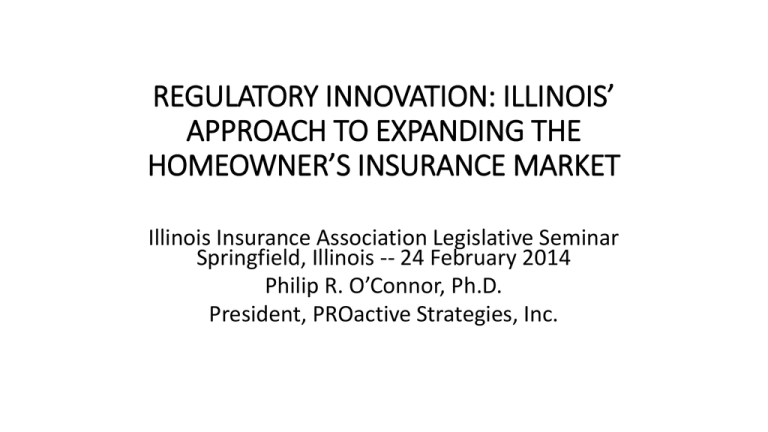
REGULATORY INNOVATION: ILLINOIS’ APPROACH TO EXPANDING THE HOMEOWNER’S INSURANCE MARKET Illinois Insurance Association Legislative Seminar Springfield, Illinois -- 24 February 2014 Philip R. O’Connor, Ph.D. President, PROactive Strategies, Inc. THE ILLINOIS COMPETITIVE PRICING MODEL: RELIANCE ON MARKETS & INNOVATIVE REGULATION • Since 1971 Illinois has operated under an “antitrust” model for P&C pricing, refraining from rate regulation. • Illinois has long been considered by academics and industry experts as one of the most competitive insurance markets in the country. • Illinois has been able to attract insurers to operate and domicile in Illinois and to meet market demand with products & supply. • This does not mean Illinois has been free of insurance cycle hard markets periods, controversy or active political debate at times. • There have been problem periods for medical malpractice, municipal liability, auto and homeowners. P&C INSURANCE CYCLES: BIG RATE INCREASES TEND TO THE BE SHORT-LIVED ACTUAL v. INFALATION ADJUSTED % CHANGE IN NET PREMIUM WRITTEN 1975-2012 THE “REDLINING” PROBLEM OF THE LATE 1970s IN ILLINOIS URBAN AREAS • Mid-1970s hard market was having a lingering impact on homeowners in urban areas considered “riskier.” • Late 1960s civil strife and demographic had profound effects on urban real estate markets, investment and insurance underwriting. • Heightened awareness of civil rights primed most people to attribute the problem of urban homeowners insurance prices and supply to racial discrimination rather than to impersonal market forces. • Members of the General Assembly, the Governor and the Dept. of Insurance were targeted by community organizations and others demanding solutions – including rate regulation. WITH A HAMMER IN HAND DOES EVERYTHING START TO LOOK LIKE A NAIL? • If the DoI had the power to regulate fire & homeowners rates, the easy political “out” on redlining would have been to focus on urban applicants experiencing prices they felt were unaffordable. • DoI did have rate authority over the FAIR Plan as the “last resort” insurer but had allowed the rates to fall well below losses leading to a large subsidy from the voluntary market insurers. • As policyholders in urban neighborhoods flowed into the FAIR plan due to non-renewals, agent & lender steering there were growing complaints about quality as well as rates (totaling 86,000 policyholders in peak year 1978). • The issue became high profile in the media and politics. STAGE 1 OF THE SOLUTION: INFORMATION, RESEARCH & DISCLOSURE • February 1977: Director Mathias commissioned first in-depth U.S. investigation into insurance redlining. • August 1977: Redlining, the Illinois Experience released. • The redlining problem was much less about racial discrimination than it was a complex of converging economic, financial and social factors. • March 1977: Insurers over $1 million in HO premium to disclose number of new, renewed, non-renewed & canceled policies by ZIP. • FAIR Plan later included in ZIP Code reporting for complete picture. • July 1978: DoI released compilation of insurer consumer complaints that helped to focus attention on insurers with problems. STAGE 2 OF THE SOLUTION: GETTING THE TOOL KIT • DoI worked with legislators, industry and others to empower the regulator and to set boundaries within which market solutions could be forged. • • • • Prohibit non-renewal by reason of race, occupation, location, age of property 60-day notice of non-renewal for policies in force >5 years Clear written reasons for non-renewal or cancellation Prohibit refusal to insure based on location of risk, or previous refusal or termination by another insurer • No policy termination by reason of termination of agent by insurer • Consumers given access to insurer file in complaint cases and fee for hearings waived and hearings held in Chicago, not just Springfield. • August 1978: All-Stakeholders Illinois Citizens Task Force on Homeowners Insurance Availability created to develop consensus, market-based reform. STAGE 3 OF THE SOLUTION: FOCUS ON INSURANCE – NOT REDLINING • A key market problem was that conventional Homeowners policies were “replacement cost” that became uneconomic for insurers when the cost to rebuild or repair older homes was far above market value. • DoI & industry cooperated to bring to market value policies that provided for repairs with modern materials and total loss coverage at market value. • FAIR Plan was the barometer of market performance – high policy count indicated lack of availability that could be identified by ZIP. • FAIR Plan offered second class coverage (only fire insurance), at price below loss costs, and risk “dumping” was too easy. • The consensus was that the FAIR Plan must be a high quality insurer: hard to get into, priced reasonably and would be only a last resort carrier. STAGE 4 OF THE SOLUTION: FOCUS ON THE FAIR PLAN • FAIR would offer range of products: HO-2, HO-8 & HO-4 • Rates would be set at the upper end of the voluntary market • Inspections before binding and inspections at least every three years would guard against “uninsurable” risks as well as arson for profit. • Improved consumer service: installment payments, prompt binding. • No renewals on commercial property 2-years in tax delinquency. • Requirement of three voluntary market refusal to insure. • Take Out and Keep Out incentives for voluntary insurers. • Restructuring of FAIR Plan board to include public members. STAGE 5 OF THE SOLUTION: ONGOING VIGILANCE & ADAPTATION • FAIR Plan’s further evolution • 1986: Plan scope expanded to entire state • 1991: Earthquake coverage offered • 1994: Added HO-3 policy and higher limits of coverage • 1998-2013: Ongoing modernization and improved customer service • 1978-2013: 93% “depopulation” from 86,000 to 6,000 policies • DoI continues to collect & review market data. FAIR PLAN POLICY COUNTS CAN FLUCTUATE DEPENDING ON MARKET CONDITIONS TOTAL HOMEOWNERS 2013 2012 2011 2010 2009 2008 2007 2006 2005 2004 2003 2002 2001 14,000 13,000 12,000 11,000 10,000 9,000 8,000 7,000 6,000 5,000 4,000 3,000 MAJORITY OF FAIR PLAN POLICIES NOW OUTSIDE CHICAGO Centralia/ Carbondale 5% Remainder of State 5% Peoria 3% Chicago Suburban 6% Chicago 54% E. St. Louis 27% Centralia/ Carbondale 11% Remainder of State 10% Peoria 5% Chicago 40% Chicago Suburban 8% E. St. Louis 26% FAIR PLAN LOSSES ARE STAYING WITHIN REASONABLE BOUNDS FOR RESIDUAL CARRIER INCURRED PAID 013 08/2 2012 2011 2010 2009 2008 2007 2006 2005 2004 2003 2002 2001 2000 1999 1998 1997 1996 1995 1994 1993 140% 130% 120% 110% 100% 90% 80% 70% 60% 50% 40% 30% “REDLINING” THREE DECADES LATER • The problem was mainly one of a mismatch between insurance products & practices and new property market realities. • The solution was to place a duty (with flexibility) on voluntary insurers to engage the market with responsive products & practices. • Insurers made maintained key commitments, including recruitment and placement of agents in previously underserved communities. • DoI has maintained a market-based philosophy with a focus on data disclosure and use of the FAIR Plan as the market indicator. • Today, FAIR Plan has 6,000 policyholders compared to 86,000 in 1978. • Redlining has not been an issue in more than 30 years. PHILIP R. O'CONNOR, PH.D. Dr. Phil O’Connor is President of PROactive Strategies, a Chicago consulting firm providing advice in the energy and insurance industries. For over two decades Phil has been recognized as a leading advocate of competitive market solutions for regulated businesses. In addition to a lengthy career in the private sector, Phil has had extensive government and political experience, having chaired the Illinois Commerce Commission serving as Director of the Illinois Department of Insurance and as a member of the Illinois State Board of Elections. Five consecutive Illinois Governors have appointed him to various boards and commissions. From March 2007 to March 2008, Phil worked in the U.S. Embassy in Baghdad, Iraq with the US Army Corps of Engineers and the US State Department as an advisor to the Iraqi Ministry of Electricity. A magna cum laude graduate of Loyola University of Chicago, Phil received his Masters and Doctorate in Political Science from Northwestern University. Phil.OConnor@PROactive-Strategies.net 312-980-4860

